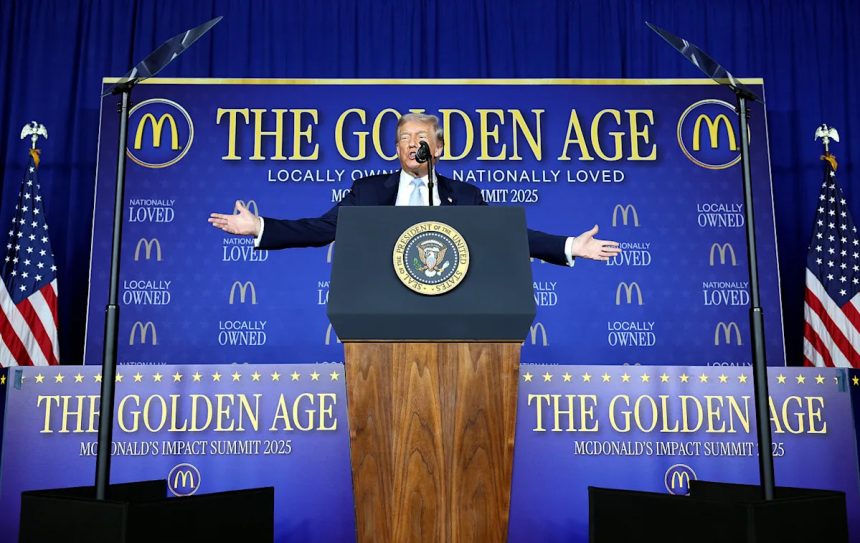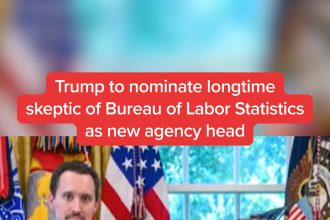“I’m honored to stand before you as the very first former McDonald’s fry cook to ever become President of the United States,” Donald Trump said as he began his remarks at a meeting of McDonald’s executives and franchise owners on Monday. It was a fitting introduction, given how it mirrored the speech that followed: misleading, superficial and positioning Trump’s efforts as a positive rather than a negative.
Trump never had an actual job at McDonald’s, of course. People born to millionaires usually don’t. He’s referring to a brief campaign trail stop he made in 2024, serving up fries to prescreened customers at a closed restaurant. The stunt was intended in part to goad his opponent, Vice President Kamala Harris, whose experience as an actual McDonald’s employee Trump had dismissed as an invention. But he was also there in hopes that the chain’s blue-collar, working-class bona fides might rub off on him.
Donald Trump works behind the counter during a campaign event at a McDonald’s restaurant in Feasterville-Trevose, Pennsylvania, on Oct. 20, 2024. (Doug Mills / Pool via Getty Images)
That was a theme of his speech before the chain’s executives this week. We are experiencing “the golden age of America,” he said, “because we are doing better than we’ve ever done as a country. Prices are coming down and all of that stuff.” As evidence of this latter point, he cited Walmart’s assertion that the price of a Thanksgiving meal was down relative to last year — a decline that is dependent on the “meal,” including fewer items and cheaper brands.
The president said that his claims that prices had fallen were validated by a senior McDonald’s official who told him (only in private, of course) that prices “were up 40% because of Biden and inflation and they’re coming down and they’re coming down rapidly.” Trump claimed that these purported price reductions were a function of his administration’s policies, including tariffs. Had he not won, he said, “you probably would have had a bankrupt country.”
“You are so damn lucky that I won that election, I’m telling you,” he told those in attendance.
If Americans — and McDonald’s franchisees in particular — are lucky, it’s probably that things haven’t been worse.
First of all, his claim that prices are coming down is not true of fast food. The Washington Post, using data from the firm Numerator, reports that the price of a fast-food meal is up relative to when Trump took office, driven mostly by increases in the price of soft drinks.
Thanks to a recent drop, the most recent data suggests that an average fast-food meal has cost an average of $14.11 over the past four weeks. Had nothing at all changed after January, the trend over the course of 2024 would have led to the average fast-food meal at this point costing … $14.12.

Data from Numerator via The Washington Post. (Philip Bump / MS NOW)
As is the case with a lot of sectors of the economy, the price of a fast-food meal has increased modestly in part because restaurants are absorbing some of the cost. The price of a fast-food entree has remained relatively flat over the course of the year, for example, despite a big jump in the price of ground beef — a pound of which is up more than 14% since January. That’s a bigger increase than the one seen in the first nine months of Joe Biden’s presidency.

Data from the Bureau of Labor Statistics. (Philip Bump / MS NOW)
The administration and its defenders will often cherry-pick specific grocery items that have declined in price, such as eggs, ignoring that prices generally have continued to rise (and that egg prices were unusually high when Trump took office due to the spread of bird flu). It is fair to assume that McDonald’s executives and franchisees know that the trend in food prices has been up, not down.
Its executives clearly do. The customer base for McDonald’s does include many lower-income Americans, meaning any economic headwinds that affect those consumers quickly affect McDonald’s, too. Over the summer, the chain publicly identified some economic warning signs affecting those customers. Sales of breakfasts — what one executive described as the “most economically sensitive” meal — had dropped as people opted to skip breakfast or eat at home.
This month, despite new pricing deals introduced earlier this year, McDonald’s announced that lower-income customers were still making fewer visits and spending less money. The slowing economy was keeping people from visiting the restaurants, as were price increases due in part to surging beef prices, as the Los Angeles Times reported.
Why are beef prices higher? In part because of tariffs on foreign imports.
Those tariffs are also a central reason for the slowdown in the economy. Consumer confidence has plunged during Trump’s second term in office, a reflection of fears about prices and, more recently, the government shutdown.

Data from the University of Michigan. (Philip Bump / MS NOW)
The president and his administration are generally unwilling to concede that his policies have negative effects on the economy, preferring to blame Biden for what’s happening 10 months into Trump’s second term. But the White House is also starting to roll back existing tariffs — including on beef — in an effort to reduce prices and potentially reverse the slowing economy.
A year ago, Trump closed down a McDonald’s so that he could pretend to work there, presenting himself as a champion of the working class and a warrior against high prices. Over the past 10 months, prices have continued to go up — including surges driven by the tariffs he’s advocated. The economy has weakened thanks to his policies, hurting McDonald’s and other businesses that rely on more economically sensitive consumers.
It seems safe to assume that many of the chain’s franchise owners don’t feel particularly lucky at all.
This article was originally published on MSNBC.com









